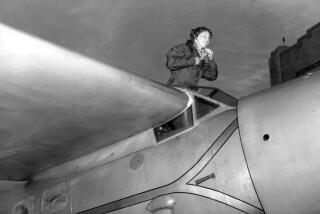Rare Plane Plucked From Ocean Floor
- Share via
After surviving 50 years with its nose buried in the ocean floor, a rare pre-World War II biplane was plucked from the waters off Del Mar by Navy divers Wednesday night and reunited with the pilot who parked it there.
The Grumman, or F3F-2, biplane, discovered in mint condition last fall, had survived the decades virtually untouched until recent weeks when a passing trawler’s fishing nets snagged the plane, the only military model in existence. The trawler dragged the aircraft about 500 feet and broke off a wing.
As the biplane was wrested from the sea, Robert Edward Galer, a retired Marine brigadier general--the plane’s pilot at the time of the crash--was waiting to greet it.
“It’s like seeing an old friend,” said Galer, now 76. Galer, a recipient of the Medal of Honor, flew from Dallas to watch sailors pull up the biplane, which was dripping with water, seaweed and swatches of the fishing net.
When Lee Wolford, salvage supervisor, handed him a pencil found in its holder in the cockpit, Galer turned to him and asked if he discovered anything else.
“No, sir. Why?” Wolford replied.
“I thought I left a couple thousand dollars in there,” joked Galer, who downed the aircraft after its engine failed at 12:30 p.m. Aug. 29, 1940.
Before Galer flew the biplane, several other pilots had flown it and complained of problems. Aboard the aircraft carrier Saratoga, a crew of engineers went to work and believed they had fixed the ill-fated biplane.
After taking off, Galer checked the fuel tanks several times, according to an accident report filed after the crash. But, as he tried to switch from one fuel tank to another, the engine began to sputter. Galer headed back toward the aircraft carrier; the engine coughed and then quit.
“I went through all the procedures, and it would not restart,” he said. “I had been flying long enough and seen enough that it wasn’t completely a surprise. I had put a couple of planes down in cow pastures, and, in an emergency landing, you just do your best.”
Galer’s best was pretty decent, Navy officials say. The biplane plunked down on the water about 300 yards astern of the carrier, floated for five minutes, then sank. Galer signaled to fellow pilot Marine Lt. C. N. Endweiss that he was not hurt.
And apparently, until recently, the plane was not hurt either. Sailors in a submersible vehicle discovered the aircraft last fall, when they were searching for a downed helicopter. At that time, it sat in perfect condition on the sea floor.
Returning this week, the Navy discovered the starboard wing had been torn; the vertical and horizontal stabilizers were mangled. But even damaged, the biplane is in “remarkably good shape,” said Ed McKellar, executive director of the San Diego Aerospace Museum. “This is the art world equivalent of finding another Monet.”
The biplane, one of only 81 manufactured, is the only military version to have survived the war. A civilian model is now housed in the Smithsonian Institution in Washington. The plane, one of the first to feature retractable landing gear, was viewed as a stopgap measure for the Navy, which was eagerly awaiting a shipment of mono-wing planes.
Although the single-seat biplane is easy to maneuver, it could carry only two machine guns, which the pilot fired after aiming the plane at a target. Even in the pre-World War II days, the plane was outpaced by those of other nations.
“It was like driving in the Indianapolis race with a Volkswagen,” McKellar said.
The biplane is now at North Island Naval Air Station, where workers are removing seaweed and treating it to prevent salt water corrosion. It’s scheduled to remain in San Diego for about three years, while being restored at the Aerospace Museum. Once restoration is completed, it will be housed at the Naval Air Museum in Pensacola, Fla.
More to Read
Sign up for Essential California
The most important California stories and recommendations in your inbox every morning.
You may occasionally receive promotional content from the Los Angeles Times.













